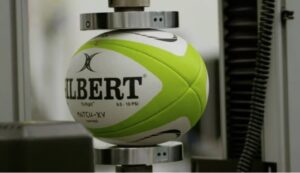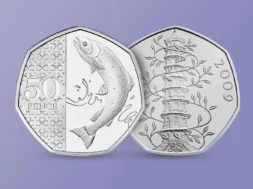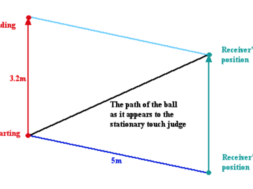
The Smart Ball has been used in several tournaments recently but what actually is it?
An often seen thread on our favourite rugby forum is the debate as to whether a pass was forward in the build up to a try or statements such as “that line-out throw was never straight”. The format often includes diagrams, videos and images of the incident to support one view or another. The news is that that these arguments may soon be resolved at source.
To date sports like tennis have utilised “Hawkeye” to increase line call accuracy. Cricket has implemented a sophisticated review system with ball tracking combined with the snickometer to asses whether a player touched the ball or not and whether he was was out.
Up until now rugby has been somewhat left behind in the race to embrace technology.
However, things are changing with the help of an English sports data company called Sportable.
The company was formed by Peter Husemeyer, a former scientist at NASA with a PhD in nuclear engineering and his partner Dugald Macdonald who has a background in private equity. They have teamed up the ball manufacturer Gilbert and Sage software to develop the “smart ball”.
Smart Ball Development
The smart ball has been in development for six years and was used in the recent Six Nations Championship as well as trialling in Australia and the recent Under 20s World Championship. These trials have been successful.
So how does it work? Unlike tennis and cricket where assessments are made from the outside looking at the action the smart ball is at the centre of the action as it is able to to be tracked very precisely with the system able to tell the speed, direction, acceleration, rotation and height through a sensor embedded within the ball itself.
The portable system has two main components the rugby ball with the sensor embedded in it and the detectors located around the field.
The sensor is an ultra-lightweight internal radio frequency (RFID) chip and battery that sits just below the valve also included is a gyroscope.
These two sensors relay data to a bank 20 portable sensor beacons. The data is then passed on to computers on the side of the field, there is a small delay but effectively it is in real-time.
Each one of the beacons talks to the ball 20 times per second the ball relays that information about its position, its spin state, the acceleration it is undergoing and can tell to within a few centimetres the distance the ball has travelled its velocity how many rotations it has gone through and how fast it has spun.
That information is combined within milliseconds to work out what is happening in the game using classification algorithms.
This data is collected whether the ball is kicked or passed and can be used to tell whether a ball has gone forward from a pass or even if a ball has been held up or not over the try line.
The technology can be used in other sports such as football, showjumping and boxing and all that information can be displayed to sports fans on screen almost instantly without need for long referrals.
The Smart Ball.
 The whole setup had to be able to withstand the rigours of the game of rugby and to not impact the size or weight of the ball. This is where Gilbert, the rugby ball manufacture comes in.
The whole setup had to be able to withstand the rigours of the game of rugby and to not impact the size or weight of the ball. This is where Gilbert, the rugby ball manufacture comes in.
Clearly the ball had to be robust enough not to be damaged when it was kicked, or landed on, or thrown about. It also needed to be unaffected by the inflation or deflation of the rugby ball. But above all it is vitally important to maintain the ball’s balance.
The sensor is small but nevertheless has a weight which could affect the ball’s rotational stability. Gilbert had to re-engineer parts of the ball to allow for that and that development was led by Its development team and it’s chief engineer Ian Savage .
World Rugby regulations stipulate a ball has to weigh between 410 and 460 grammes Gilbert’s smart ball is between 455 and 460 grammes. The battery and chip weigh between 20 and 30 grammes the stipulated ball pressure is 9.5 (PSI).
The Sensor Beacons
Once the data is collected by the beacons it needs to be processed and an additional partner Sage, the accounting software specialists have been instrumental in making it work.
The ball was originally tested at Grange Road, Cambridge University’s ground and Loughborough University did much of the work to ensure that when somebody kicked it, it didn’t break or shatter.
The technology is transferable to many sports and has huge potential but for us rugby fans its biggest benefit is that we can rest assured that decisions on the rugby field will be accurate and almost instantly relayed to our screens.
For sports clubs there is an addition issue when designing grounds in that once the smart ball is fully operational and integrated the spectators that have paid their entrance fee would not have access to the extensive range of readouts. Perhaps its time for an integrated screen in your seat to redress the balance?
Sage have been instrumental in highlighting the Smart Ball in rugby and the involvement of ex players such as Maggie Alphonsi, Tommy Bowe, Paul Grayson, Sam Warburton and George Gregan has been key, they include a video of the smart ball in action.
How Can the Smart Ball Aid Coaches and Referees?
- Velocity: Measuring the speed at which the ball is thrown, kicked, or passed.
- Spin Rate: Calculating the rotational speed of the ball, which affects its trajectory and accuracy.
- Impact Force: Tracking the force of impacts when players catch, pass, or kick the ball.
- Flight Path: Monitoring the ball’s trajectory and predicting where it will land.
- Grip Analysis: Evaluating how well players can grip the ball, which could help in analysing handling skills.
- Drop/Kick Analysis: Analysing the flight path and accuracy of drop kicks and conversions.
The advantages of using a smart ball in rugby could be significant:
- Performance Analysis: Coaches and players can access real-time data on various ball-related metrics, allowing them to analyse and improve their skills, passing accuracy, kicking techniques, etc.
- Injury Prevention: The data collected by the smart ball can help identify patterns of forceful impacts, contributing to a better understanding of the potential risk of injuries, especially for players involved in frequent tackles or contact situations.
- Refereeing Assistance: Smart balls could be used to verify try-line decisions or kicking accuracy, helping referees make more accurate calls during the match.
Finally obviously, Fan Engagement: Smart balls could enhance the viewing experience for fans by providing additional data and insights during broadcasts, creating a more immersive and engaging experience












